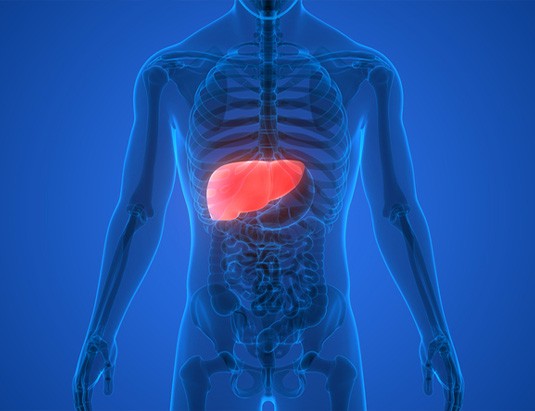
Non-Alcoholic Steatohepatitis
Non-Alcoholic Steatohepatitis (NASH), or fatty liver disease, means that you have fat inside your liver that can, over time, affect liver function and cause liver injury. It is the “silent” liver disease that deserves more attention. NASH resembles alcoholic liver disease, but it occurs in people who drink little or no alcohol.
Liver Overview: An Unsung Hero
Your liver is one of the body’s unsung heroes. Its work is essential to our existence. It transforms food into usable nutrients, stores these nutrients, and provides them to cells when they’re needed.
It also neutralizes toxins by converting them into harmless substances or making sure they are eliminated directly from the body. Twenty-four hours a day, your liver takes in unclean blood, filters it, refreshes it, and then releases clean blood back into your body. Yet, we rarely think about our liver. Or liver disease.
Types of Fatty Liver Disease
Fatty liver disease is divided into two types. If you just have fat but no damage to your liver, the condition is called non-alcoholic fatty liver disease (NAFLD). If you have fat in your liver plus signs of inflammation and liver cell damage, the disease is called non-alcoholic steatohepatitis (NASH).
About 10% to 20% of Americans have NAFLD. About 2% to 5% have NASH. Both are growing problems. According to the American Liver Foundation:
- About 100 million individuals in the United States are estimated to have Nonalcoholic Fatty Liver Disease.
- Nonalcoholic Fatty Liver Disease (NAFLD) is the most common form of liver disease in children and has more than doubled over the past 20 years.
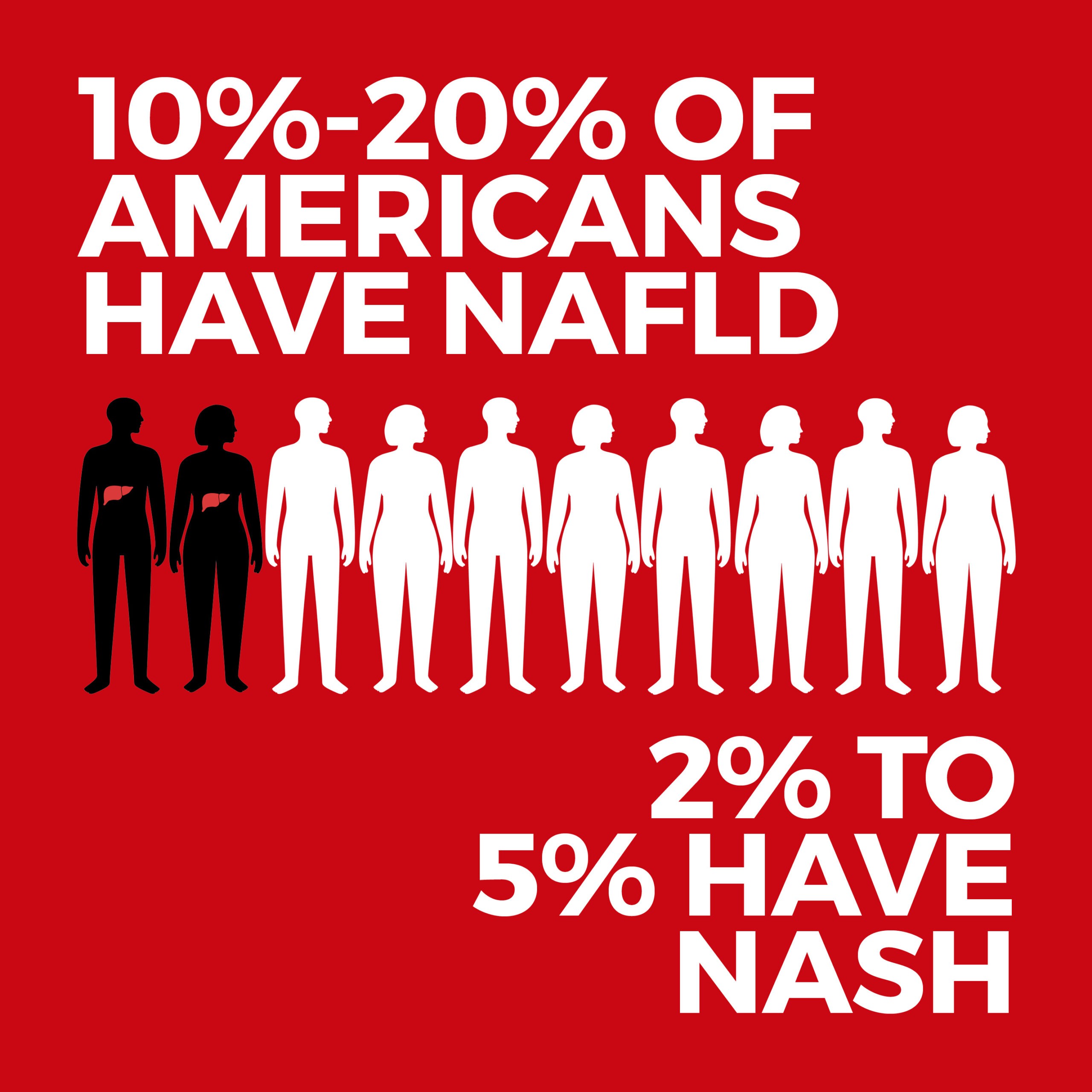
Symptoms
Fatty liver disease is sometimes called a silent liver disease because it can happen without causing any symptoms. Most people with NAFLD live with fat in their liver without developing liver damage. A few people who have fat in their liver develop NASH.
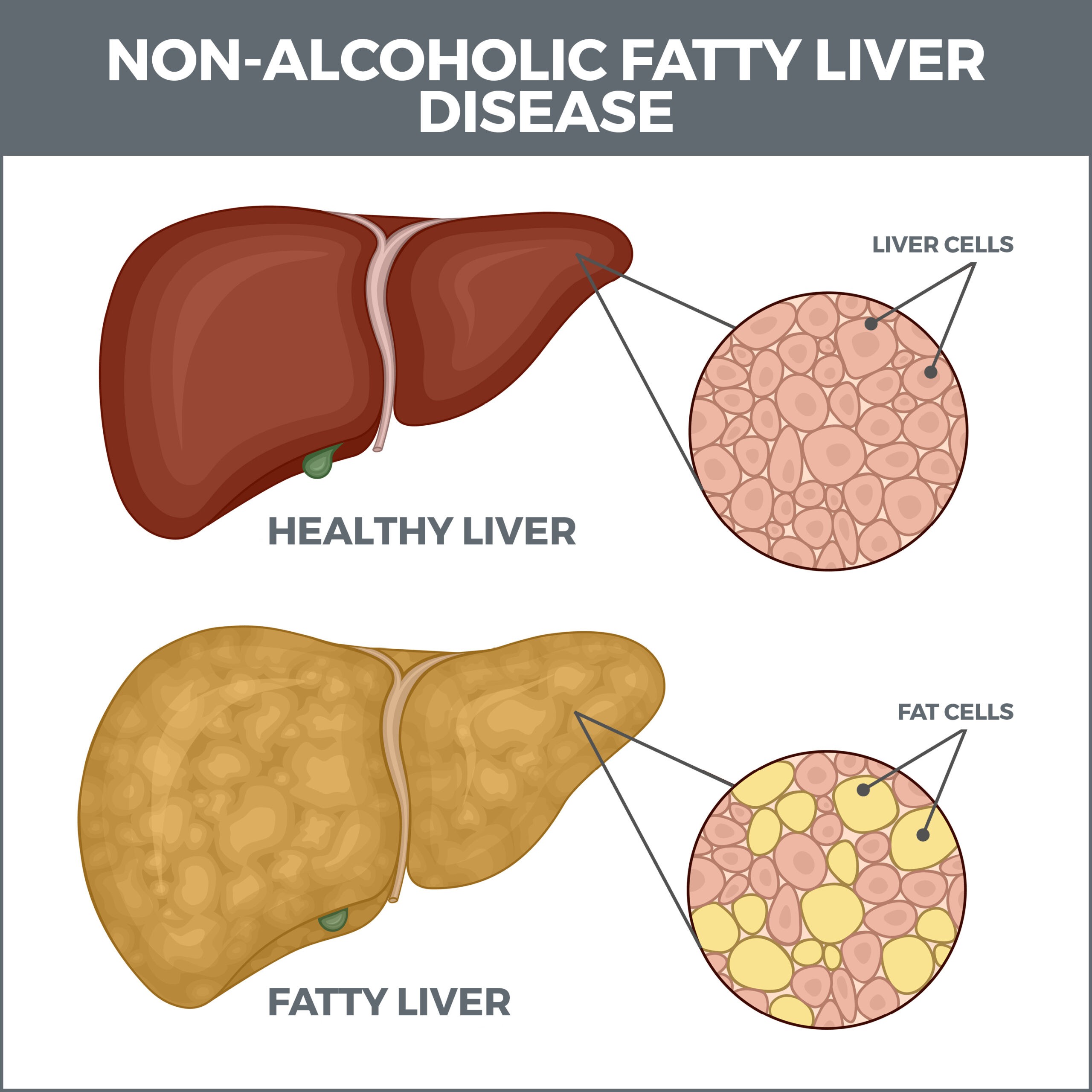
If you have NASH, you may have symptoms that could take years to develop. If liver damage from NASH leads to permanent scarring and hardening of your liver, this is called cirrhosis.
Symptoms of NASH may include:
- Severe tiredness.
- Weakness.
- Weight loss.
- Yellowing of the skin or eyes.
- Spider-like blood vessels on the skin.
- Long-lasting itching.
NASH that turns into cirrhosis could cause symptoms such as:
- Fluid retention.
- Internal bleeding.
- Muscle wasting.
- Confusion.
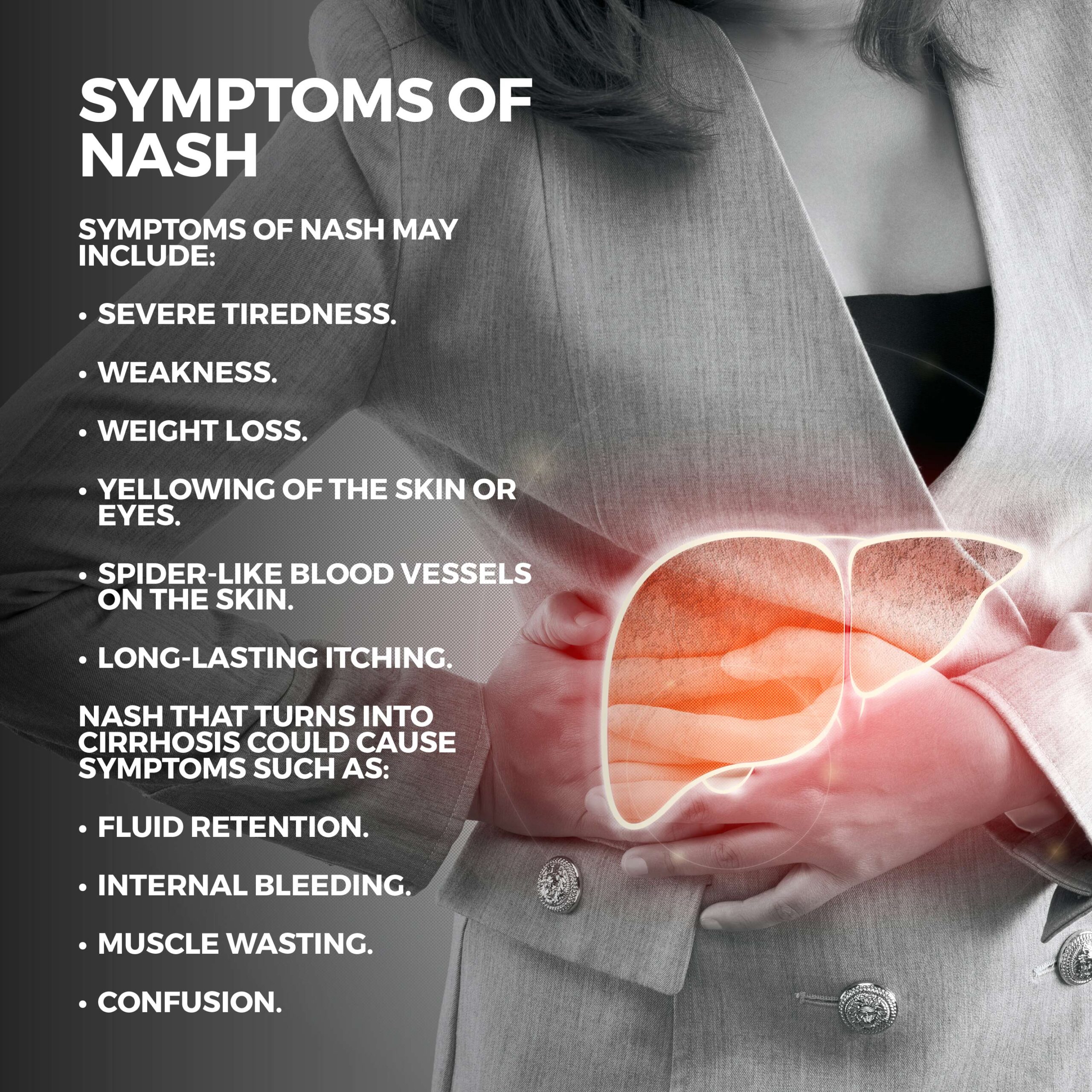
When liver damage progresses, it can lead to cirrhosis. This means that scar tissue replaces healthy tissue. Over time, this scarring can worsen, increasing the risk of liver failure and the need for a liver transplant.
When Should You See a Doctor?
People typically don’t experience symptoms until NAFLD progresses to NASH (non-alcoholic steatohepatitis). With NASH, you may begin to have symptoms of inflammation, such as pain and swelling in your upper right abdomen, where your liver is. But you may not notice symptoms until NASH has progressed to more severe liver damage; NAFLD merely lays the groundwork.
Anyone who has symptoms of a metabolic disorder should see a doctor. But there may be no symptoms of NASH or liver disease. So, regular checkups are important for people with a higher risk.
Anyone with multiple risk factors, a family history of NASH, or metabolic syndrome (a cluster of conditions that increase the risk of heart disease, stroke, and diabetes) should receive a risk assessment and possibly tests to check their liver health.
Risk Factors
Many factors increase your risk of developing Non-Alcoholic Steatohepatitis. Some include:
- Being overweight.
- High blood fat levels are either triglycerides or LDL (“bad”) cholesterol.
- Having diabetes or prediabetes.
- Having high blood pressure.
Some people develop non-alcoholic fatty liver disease even if they do not have any risk factors. Non-alcoholic fatty liver disease affects up to 25% of people in the United States.
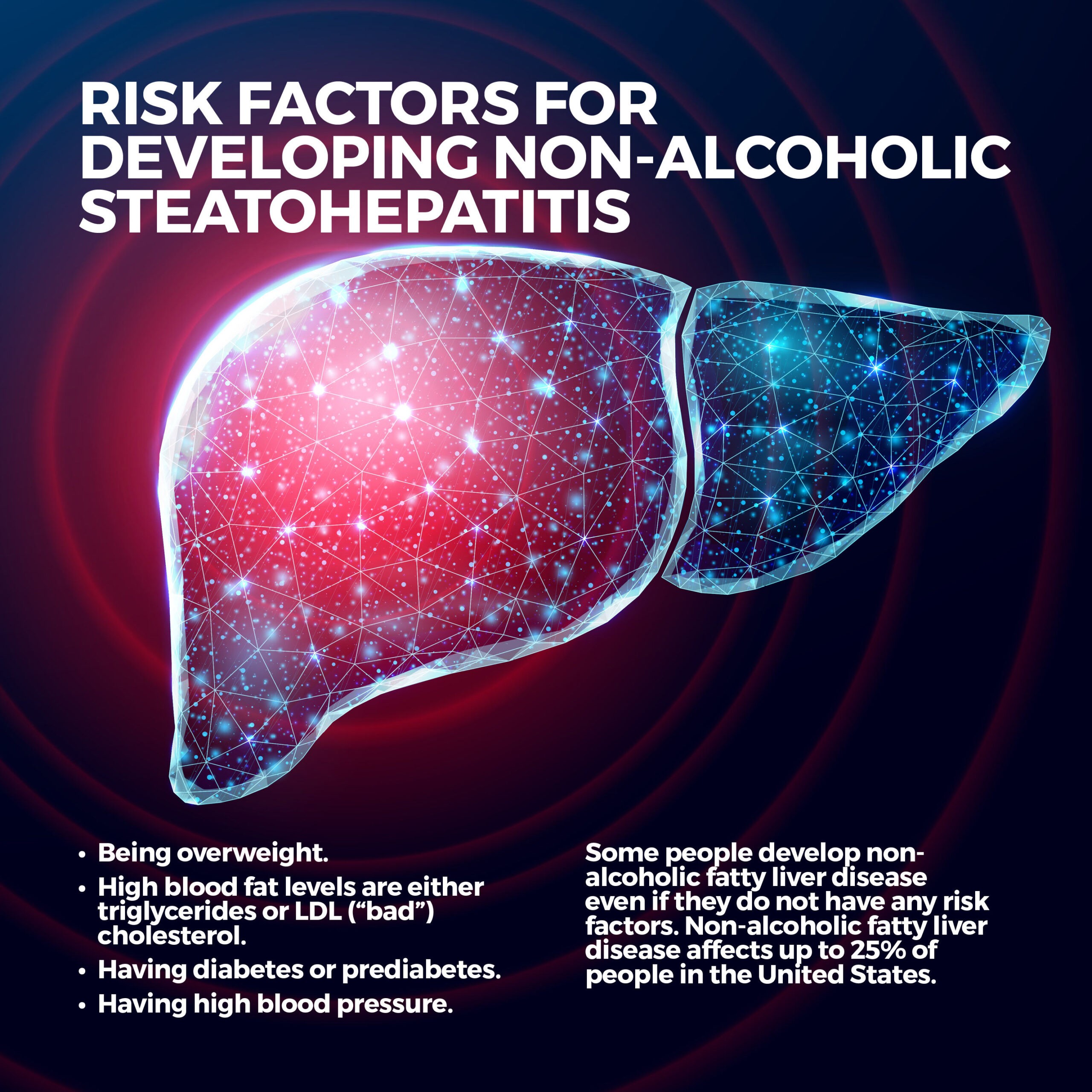
Causes
Certain genes may make you more likely to develop NAFLD. This may help explain why some people get it without any of the other common risk factors. It may also help explain why people of certain races seem to get it more often.
The exact causes of non-alcohol-related fatty liver diseases are not well understood. A sedentary and unhealthy diet can increase the chances of it developing.
Obesity in the U.S. has doubled in the last decade, and physicians are seeing a steady rise in fatty liver disease. Although children and young adults can get fatty liver disease, it is most common in middle age.
Questions to Ask Your Doctor
- What condition do I have that suggests NAFLD?
- Can NAFLD be reversed? How long can this process take?
- Do I have cirrhosis or scarring of the liver?
- If I do have cirrhosis – how far has the scarring progressed?
- What kinds of lifestyle changes and diet can I make?
- Would it be possible to be connected to a registered dietitian or nutritionist to make a specific meal plan?
- What kinds of physical activities would be OK for me to do?
- Is there a treatment or medication for NAFLD? Are there any clinical trials?
- Will losing weight help me to get rid of this disease?
Diagnosis
Since fatty liver disease can happen without causing any symptoms, it’s usually diagnosed when you have routine blood tests to check your liver. Your gastroenterologist may suspect fatty liver disease with abnormal test results, especially if you are obese.
Imaging studies of your liver may show fat deposits. Some imaging tests, including special ultrasound and MRI scans, can help diagnose the disease and spot scar tissue in the liver. But the only way to be certain that fatty liver disease is the only cause of liver damage is with a liver biopsy. A liver biopsy involves getting a tissue sample of your liver with a needle. The needle removes a small piece of liver tissue that can be looked at under a microscope. Here’s how doctors make the diagnosis:
- If you have fat but no inflammation or tissue damage, the diagnosis is NAFLD.
- If you have fat, inflammation, and liver damage, the diagnosis is NASH.
- If you have a type of scar tissue in your liver called fibrosis, you may be developing cirrhosis.
Treatment
The effects of NASH can be reversible, mainly through lifestyle modifications. Changes such as eating healthier, increasing activity, and losing weight can improve or even reverse the effects of NASH.
If you have NAFLD without other medical problems, you don’t need special treatment. But making some lifestyle changes can control or reverse the fat buildup in your liver. These may include:
- Losing weight.
- Lowering your cholesterol and triglycerides.
- Controlling your diabetes.
- Avoiding alcohol.
If you have NASH, no medication is available to reverse the fat buildup in your liver. In some cases, the liver damage stops or even reverses itself. But in others, the disease continues to progress. If you have NASH, it’s important to control any conditions that may contribute to fatty liver disease. Treatments and lifestyle changes may include:
- Losing weight.
- Medication to reduce cholesterol or triglycerides.
- Medication to lower blood pressure.
- Medication to control diabetes.
- Limiting OTC drugs.
- Avoiding alcohol.
- Seeing a liver specialist.
Some medications are being studied as possible treatments for NASH. These include antioxidants like vitamin E. Since many medications can harm your liver, always let all your doctor know about any medications you are currently taking. These include OTC drugs, dietary supplements, and vitamins.
Contact Us
Whether you’re having symptoms or not, it’s a good idea to reach out to us and schedule an appointment to address Non-Alcoholic Steatohepatitis.
Contact us today! The team of professionals at GastroMD looks forward to working with you. We are one of the leading gastroenterology practices in the Tampa Bay area. We perform a host of diagnostic procedures using state-of-the-art equipment in a friendly, comfortable, and inviting atmosphere where patient care is always a top priority!



